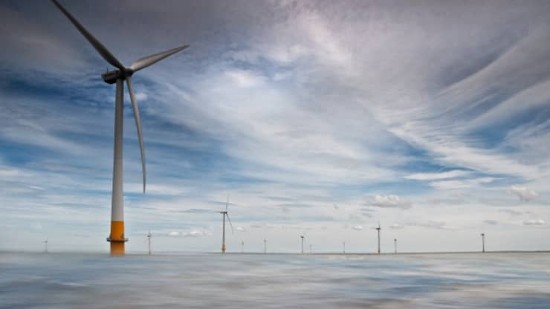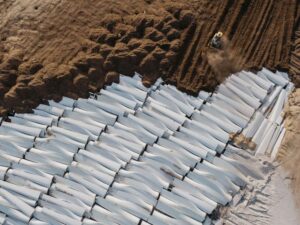Wind turbines are being used today along with solar and geothermal technologies to displace fossil fuel-based power generation. The technology uses enormous rotating fan blades to capture latent energy from the atmosphere and convert it into electricity. But the wind turbine blades we have been building to date do not last forever and the materials from which they are made produce waste that is difficult to recycle. What is needed to deal with the waste problem is better methods of material recovery, and better manufacturing processes to eventually eliminate waste entirely.
The first generation of wind turbine blades were made from combinations of balsa wood, glass, carbon fibre, and resins, bound together with glues that proved difficult to remove. Hence these blades have largely ended up in landfill graveyards like the one seen below. Trying to recover materials from them has largely been unsuccessful so they lie in pits looking like row upon row of ghosts.
A Spanish company, Reciclalia, however, has developed new methods for separating the glass and carbon fibre and currently can recycle 1,500 blades per year. Recovered content can’t be used for new turbine blades, but the material is sufficiently strong for automotive, nautical, construction, and consumer product use. The materials recovered can replace thermoset or thermoplastics, engineered plastics, and metals.
Reciclalia’s patented portable Constrictor technology is designed specifically to go to wind farm sites as seen in this Youtube video where the technology chops up dismantled turbine blades and crushes them, minimizing waste and eliminating the need for transportation to an offsite facility.
The company also provides a recycling process that eliminates the resins from the composite materials with less than 10% degradation. The end result is resaleable 100% resin-free materials for different industrial uses including carbon fibre, chopped glass, and glass fibre strands of various thicknesses.
The company was one of four that recently won the first edition of the Retina Eco Award, given by Capgemini and ElPais Retina to organizations and companies providing sustainable and innovative technologies to support global efforts to mitigate climate change and the environment. A jury of scientists and business people picked the company and its technology partner Técnicas Reunidas from 115 candidates who submitted projects covering green energy generation, efficient consumption, smart mobility, and sustainable economics.
Refurbishment of wind turbine blades for current and future farms is expected to produce demand for recycling of an estimated 200,000 blades over the next three decades. In a published 2017 paper produced by researchers from the University of Cambridge, they concluded that the waste produced from used turbine blades will amount to 43.4 million tons by 2050.
A Danish company, Vestas is attempting to address the issue by producing a value chain for the manufacturing and lifecycle of wind turbine blades to achieve zero waste throughout its production processes and supply chain by 2040. Vestas intends to implement circular economic principles in its design, production, service, and end-of-life. In a CNBC article published in 2020, Tommy Rahbek Nielsen, Interim Chief Operations Officer at Vestas, stated, “As the world’s largest supplier of wind energy, Vestas has a responsibility to eliminate waste across its value chain.” He continued, “Wind energy will continue to grow rapidly, therefore the time for a conservative approach is behind us.” The International Energy Agency (IEA) has stated that offshore wind farms will be a $1 trillion business by 2040.










